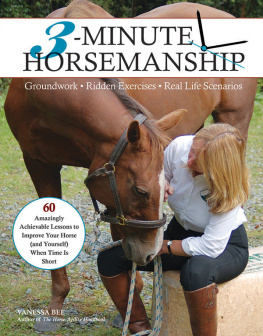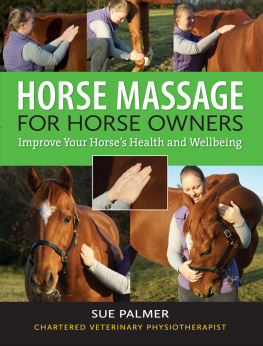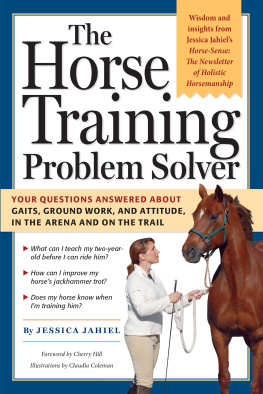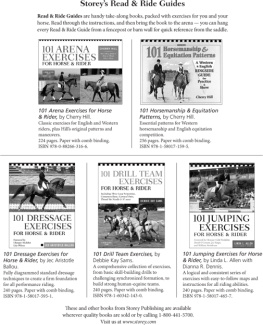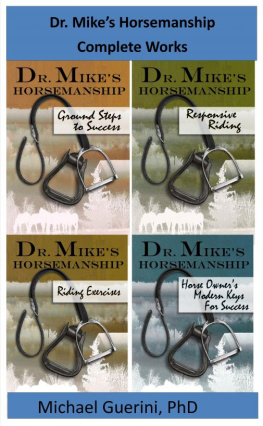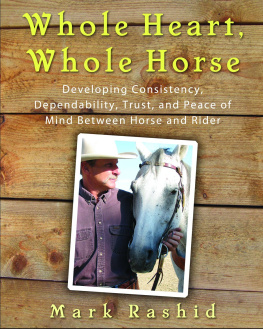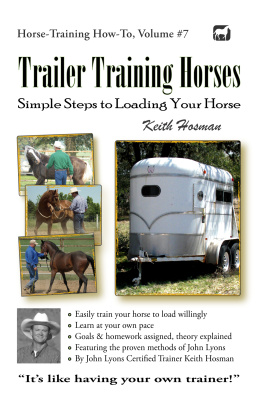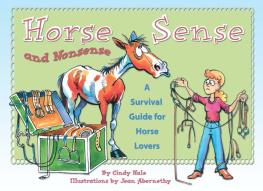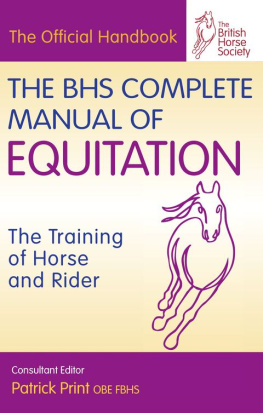60 Amazingly Achievable Lessons to
Improve Your Horse When Time Is Short
VANESSA BEE
First published in 2014 by
Trafalgar Square Books
North Pomfret, Vermont 05053
Printed in China
Copyright 2013 Vanessa Bee
All rights reserved. No part of this book may be reproduced, by any means, without written permission of the publisher, except by a reviewer quoting brief excerpts for a review in a magazine, newspaper, or website.
Disclaimer of Liability
The author and publisher shall have neither liability nor responsibility to any person or entity with respect to any loss or damage caused or alleged to be caused directly or indirectly by the information contained in this book. While the book is as accurate as the author can make it, there may be errors, omissions, and inaccuracies.
Trafalgar Square Books encourages the use of approved safety helmets in all equestrian sports and activities.
Library of Congress Cataloging-in-Publication Data
Bee, Vanessa.
3-minute horsemanship : 60 amazingly achievable lessons to improve your horse when time is short / Vanessa Bee.
pages cm
Includes index.
ISBN 978-1-57076-620-6
1. Horses--Training. 2. Horsemanship. I. Title. II. Title: Three-minute horsemanship.
SF287.B368 2013
636.10835--dc23
2013009920
All photographs by Philip Osborne except pp. 13 and 29 (bottom) by Bob Atkins and p. 147
Dusty Perin/www.dustyperin.com
Book design by Peter Holm, Sterling Hill Productions
Cover design by RM Didier
Typefaces: Calisto and Agenda
10 9 8 7 6 5 4 3 2 1
Dedication
This book is dedicated to all the horses
I have ever knownthank you for teaching me.
CONTENTS
PART ONE: ON THE GROUND
Why Work on the Ground When You Can Ride Instead?
The 35 Ground Exercises
PART TWO: IN THE SADDLE
Ground Skills to Riding SkillsMaking Life Simple!
The 25 Ridden Exercises
PART THREE: REAL LIFE SCENARIOS
Using 3-Minute Horsemanship in Real Life
15 Real Life Scenarios
ACKNOWLEDGMENTS
My grateful thanks go to the team at Trafalgar Square Books for their continuing support and encouragement.
Thank you to Robert and Jacqueline McCormick of Kyogle, Australia, who started me on my horsemanship journey many years ago.
Thank you also to my husband, Philip, who took many of the photographs, and to my friends and their beautiful horses who helped by appearing in some of them. Thank you:
Clancy and Ziggy
Ray Squire, my farrier
Faye and Dan from the rescue organization P4P
(people4ponies.co.uk)
Pauline and Topaz
Elaine and Chunky
Lord and Lady Leasefield and their horses Chunky and Buster
Julie and Rupert
Sue and Merry
Lesley and Bella
But most of all my greatest thanks go to Secret, the horse who has taught me so muchshe is a horse in a million.
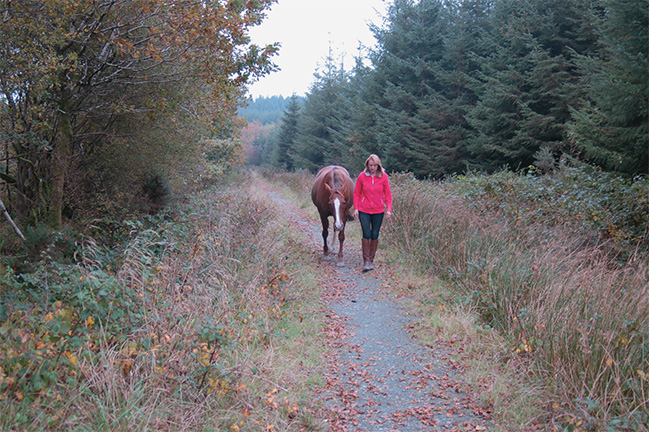
INTRODUCTION
HOW TO USE THIS BOOK
This book has been especially written for you, the time-starved, twenty-first-century horse owner. Day after day you make a promise to train yourself and your horse to be better at something, but when you get to the barn there just doesnt seem to be enough time.
Well, all this is about to change. Whether you are an accomplished horseman or a complete beginner, you will find that 3-Minute Horsemanship is ideal when time is short.
Dont worry. Im not going to tell you to read the book all the way through because I know you havent got time! As you look through these pages you will see that there are three distinct Sections:
- Part One: Ground Exercises. The first is devoted to demonstrating 35 3-Minute Exercises-all in hand to develop various skills.
- Part Two: Ridden Exercises. The next 25 exercises are all performed on the horses back.
Both Parts One and Two contain short, achievable tasks that can be built upcombined with othersto draw on when you are faced with a real-life more complicated challenge.
- Part Three: Real Life Scenarios. Here are 20 commonly experienced challenges, which you can solve by using a combination of the exercises learned in Parts One and Two.
We often look at the big task and just give up because it seems too much to fit into our busy lives. In Part Three, I show you how to break any challenge down into small manageable exerciseswithout stress for you or your horse.
This is not a program; you are not ticking boxes before moving on.
Instead, you can dip into any one of the 3-Minute Exercises and work on it that day because thats what you feel like doing. A few exercises need previous ones to help them get started, but mostly they work successfully when done on their own.
What really matters is the quality of the training and how you finish the session. Many of us give up because something isnt working. What message does that send to the horse? Not a good one, obviously. On the other hand, when we stop because an exercise is working, we feel good, the horse feels good, and there is another building block to success. It really is possible to carry out good-quality progressive training with your horse in only three minutes a day when you work in this way.
So when you have a specific training problem to solve, start by looking in Part Three at the Real Life Scenarios. But, if you just want to improve your horsemanship in a general way, you can dabble away to your hearts content in the Parts One and Two, and watch you and your horse really improve in just three minutes a day.
As you develop your ground work and riding techniques these movements will become more subtle until, to the onlooker, there seems to be no physical movement as you communicate with your horse. This book is not about classical equitation; its a book about working with your horse in such a way that you both learn to work together quietly and harmoniously. Once this has been achieved you can start to work on the finer points of your horsemanship.
WHY 3 MINUTES?
It was while I was training my horses and ponies for Horse Agility that I began to notice that when the teaching session was short, ending on a positive note, the animals appeared to learn more quickly.
Due to my other work commitments, my daily training time was limited, so I would set small, achievable tasks for each horse to be sure that we could reach a positive conclusion in the time I had available. Because the question I asked of the horse was so simple, as soon as he had either completed the task, or made some headway toward achieving it, I would stop and reward him. I was amazed at how quickly the horses learned a new skill even though the sessions were so short. However, I became even more interested when I realized that when I set up a session with a realistic goal,

